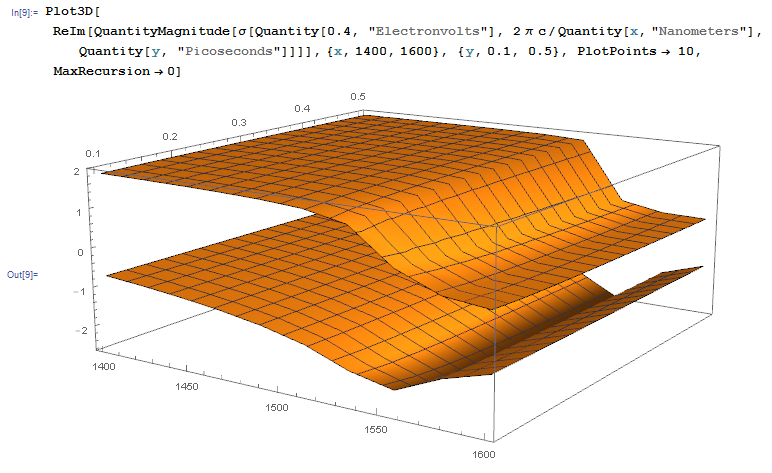Well
In[33]:= Clear[e, k, \[HBar], c, \[Omega], T, \[Tau], \[Sigma]]
e = Quantity["ElementaryCharge"];
k = Quantity["BoltzmannConstant"];
\[HBar] = Quantity["ReducedPlanckConstant"];
c = Quantity["SpeedOfLight"];
(* \[Omega]=2 \[Pi] c/\[Lambda];
\[Lambda] = Quantity[445,"Nanometers"];
\[Tau] =Quantity[0.2,"Picoseconds"]; *)
T = Quantity[300, "Kelvin"];
\[Sigma][\[Mu]_, \[Omega]_, \[Tau]_] :=
I (e^2 k T)/(\[Pi] \[HBar]^2 (\[Omega] + I/\[Tau])) (\[Mu]/(k T) +
2 Log[Exp[-\[Mu]/(k T)] + 1]) +
I e^2/(4 \[Pi] \[HBar]) Log[(2 Abs[\[Mu]] - \[HBar] (\[Omega] +
I/\[Tau]))/(2 Abs[\[Mu]] + \[HBar] (\[Omega] + I/\[Tau]))]
In[40]:= \[Sigma][Quantity[0.2, "ElectronVolts"],
2 \[Pi] c/Quantity[1400, "Nanometers"], Quantity[0.2, "Picoseconds"]]
Out[40]= Quantity[(1.90904 - 0.0426355 I), (
"BoltzmannConstant" (
"ElementaryCharge")^2 "Kelvins" \
"Picoseconds")/("ReducedPlanckConstant")^2]
In[41]:= UnitConvert[%]
Out[41]= Quantity[(0.0000608367 - 1.3587*10^-6 I), (("Amperes")^2 (
"Seconds")^3)/("Kilograms" ("Meters")^2)]
In[46]:= QuantityMagnitude[\[Sigma][Quantity[0.2, "ElectronVolts"],
2 \[Pi] c/Quantity[1400, "Nanometers"],
Quantity[0.2, "Picoseconds"]]]
Out[46]= 1.90904 - 0.0426355 I
and it is plottable like
Plot3D[ReIm[QuantityMagnitude[\[Sigma][Quantity[0.4, "Electronvolts"],
2 \[Pi] c/Quantity[x, "Nanometers"],
Quantity[y, "Picoseconds"]]]], {x, 1400, 1600}, {y, 0.1, 0.5}, PlotPoints -> 10, MaxRecursion -> 0]

The real part is above. If one unuses the options PlotPoints -> 10, MaxIterations -> 0 the plot takes a very long time. Using Quantity in numerics and graphics is definitely an overkill borderlining abuse, the usual method is to compute dimensionless expressions by remembering the actual physical dimension only in plot labels and axes labels.